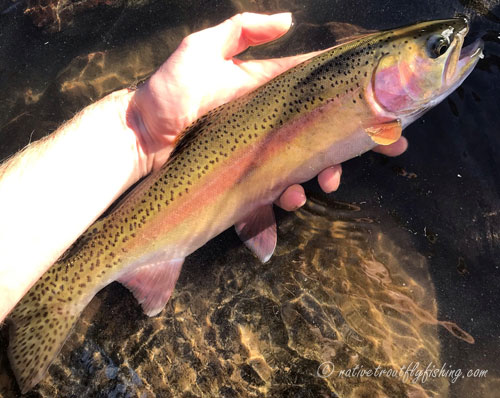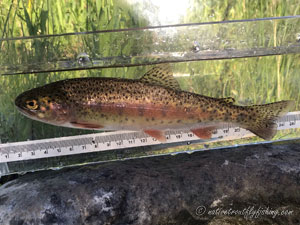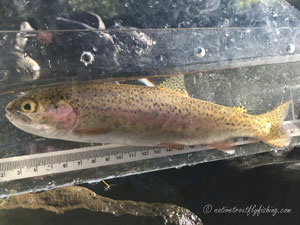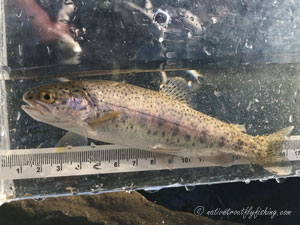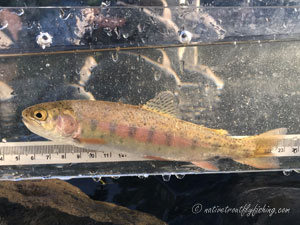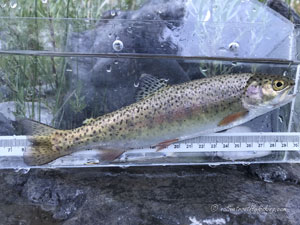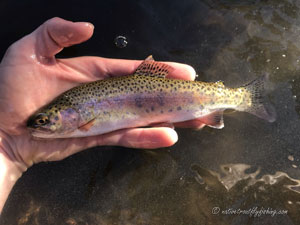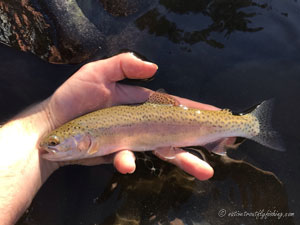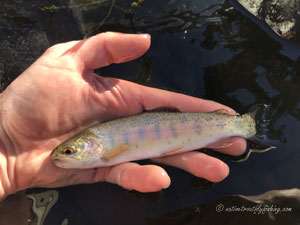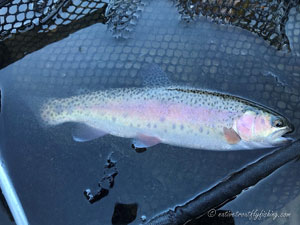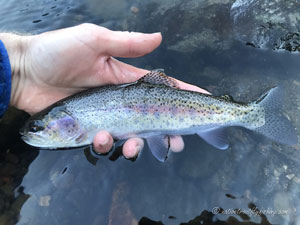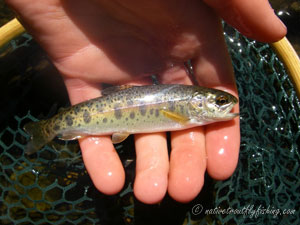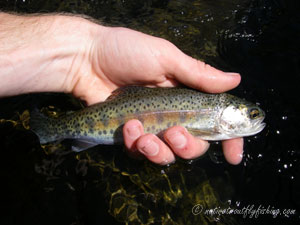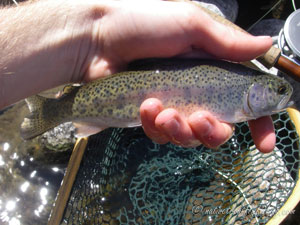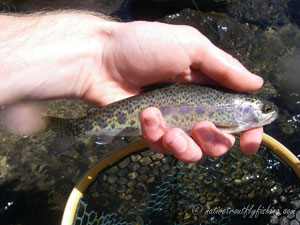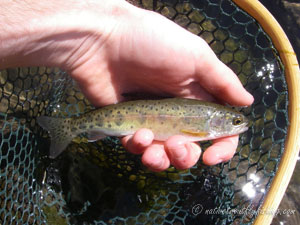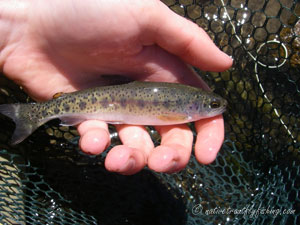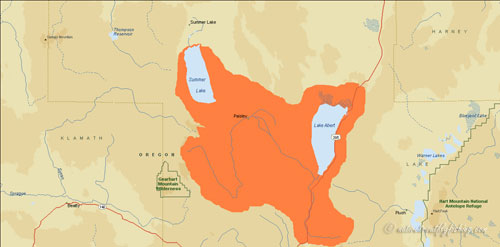Chewaucan Basin Redband
Oncorhynchus mykiss stonei
A Chewaucan Basin Redband from an Oregon desert stream
Introduction
Chewaucan Basin Redband Trout are native to streams flowing into Lake Albert and Summer Lake in Southcentral Oregon. These fish are most closely related to the Redbands of Goose Lake and the Warner Valley and are often classified as part of the subspecies Oncorhynchus mykiss newberrii (Behnke 2002), although genetically they are most closely associated with Redbands of the Sacramento River (Currens et al. 2009).
Life History Information
During the Pleistocene period the Chewaucan Basin was filled with a large lake that supported adfluvial Redband Trout, but today Summer Lake and Lake Albert are all that remain of this ancient lake. These two lakes are highly alkaline and as such are completely barren of fish (Behnke 1992). There are currently four streams in the basin containing populations of native Redbands, one flowing into Summer Lake and three flowing to Lake Albert (ODFW 2005). The most common life histories exhibited by the trout in the basin are fluvial and stream resident. The fluvial population spawns in the upper reaches of the Chewaucan River watershed and migrates to the lower reaches of the river where they feed and overwinter. Historically adfluvial fish also occurred in the basin, but the draining of the Chewaucan Marsh and construction of weirs, which blocked migration, eliminated this life history (ODFW 2005). However, in 1994 the Rivers End Reservoir was constructed near the mouth of the Chewaucan River and since then the adfluvial life history has been reestablished in the basin (ODFW 2005). The peak migration of juvenile adfluvial Redbands into the reservoir occurs from late March to April at age-1 to age-2. These fish rear in the reservoir for two years, growing quickly with an average size of 17” to 20” (44 to 50 cm) (Tinniswood 2007). Upstream migrating adults are predominately age-3 to age-4 and begin migrating back upstream in January. Tinniswood (2007) indicated that 86% of the fish spawn in Dairy and Elder Creeks or the main stem Chewaucan River and that peak spawning occurs between late March and June. Repeat spawning appears to be common, with 36% of in the adfluvial population being repeat spawners, post spawn fish generally migrate back downstream starting in mid-April.
Status
Although a 1997 petition to list all of the Great Basin Redbands as Threatened under the Endangered Species Act (ESA) was denied (USFWS 1997), the Oregon Department of Fish and Wildlife (ODFW) still considers the Redband Trout native to the Chewaucan basin to be potentially at risk of extinction. The most recent abundance estimate for the Chewaucan Basin Redbands was 149,103 fish age-1 or older (Dambacher et al. 2009). The primary threats facing the Chewaucan Redbands include degraded habitat conditions and barriers to migration. The Chewaucan Marsh was historically an important feeding and overwintering habitat for these trout, but it was diked, channelized, and drained for agricultural purposes (ODFW 2005). Migration to the Chewaucan Marsh and Rivers End Reservoir was also blocked by several irrigation weirs. Tinniswood (2007) showed that 94% of post spawn downstream migrants were diverted into irrigation ditches prior to reaching the reservoir and documented passage problems for juvenile trout. Starting in 2006 fish ladders were constructed at the weirs to restore access to spawning habitat found in the upper reaches of the basin (ODFW 2005), which appears to be having a positive effect on the population. The destruction of riparian vegetation, erosion and head-cuts caused by livestock has also been an issue throughout the basin. Wildfires are also becoming greater threat to these Redbands and in 2020, over 50,000 acres along the Chewaucan River Basin were burned during the Brattain Fire. The combination of loss of vegetation and erosion from fires and ranching, lead to elevated stream temperatures and increased siltation during spawning. Non-native fish present another threat to Chewaucan Basin Redband population, through hybridization, competition, and predation. Hatchery Rainbow Trout were stocked throughout much of the basin up until 1998, and Behnke (1992) showed that there was at least some hybrid influence present in fish from the Chewaucan River drainage. Fortunately, based on recent genetics work, it appears as though introgression with hatchery Rainbow Trout has not substantially impacted the Chewaucan Redband (DeHann et al. 2015). The main threats from non-native fish today come from competition and predation from introduced Largemouth Bass and Brown Bullheads which are found in the reservoir and lower reaches of the river and Brook Trout in the upper parts of the watershed (ODFW 2005). Miller et al. (2014) showed that in stream reaches where both Brook Trout and Redband Trout were present, there were lower densities of Redbands, although there was a great overall trout density indicating that the two species are likely using different habitat and that competition was not likely having a major impact.
Description
The coloration of the Chewaucan Redband is olive or bronze on the back and transitions to a greenish-yellow or yellowish color across the body. These Redbands have a pink to brick red stripe along their lateral line, and their gill plates are a rosy color. The spotting pattern consists of small irregular shaped spots that are distributed primarily above the lateral line but may occur below the lateral line on some fish. Purplish colored elliptical shaped parr marks are often retained into maturity in stream resident fish but may fade away in larger migratory individuals. Spots are also found on the caudal and dorsal fins. The lower fins are orange, with the caudal fin being forked. The dorsal fin may be tipped with either white or orange and the lower fins are tipped with white.
Stream Resident Form
Click on images to view a larger picture
Native Range
A map of the native range of the Chewaucan basin redband trout. Data Sources: Behnke (2002) and ODFW (2005).
References
Behnke, R. J. 1992. Native trout of western North America. American Fisheries Society Monograph 6. American Fisheries Society, Bethesda, Maryland.
Behnke, R.J. 2002. Trout and Salmon of North America. Chanticleer Press, New York.
Currens, K.P., C.B. Schreck and H.W. Li. 2009. Evolutionary ecology of redband trout. Transactions of the American Fisheries Society 138: 797–817.ODFW. 2005. Oregon native fish status report. Oregon Dept. of Fish and Wildlife, Salem, OR.
Dambacher, J.M., K.K. Jones and D.P. Larsen. 2009. Landscape-level sampling for status review of Great Basin Redband Trout. North American Journal of Fisheries Management 29:1091–1105.
DeHaan, P., J. Von Bargen, M. Meeuwig and S. Clements. 2015. Great Basin redband trout genetic status assessment. United States Fish and Wildlife Service. Longview, Washington.
Miller, S.A., S. Gunckel, S. Jacobs and D.R. Warren. 2014. Sympatric relationship between redband trout and non-native brook trout in the Southeastern Oregon Great Basin. Environmental Biology of Fishes 97(4): 357-369.
ODFW. 2005. Oregon native fish status report. Oregon Dept. of Fish and Wildlife, Salem, OR.
Tinniswood, W.R. 2007. Adfluvial life History of Redband Trout in the Chewaucan and Goose Lake Basins. Pages 99–112 in R. K. Schroeder and J.D. Hall, editors. Redband trout: resilience and challenge in a changing landscape. Oregon Chapter, American Fisheries Society, Corvallis.
U.S. Fish and Wildlife Service (USFWS). 1997. A petition for rules to list great basin redband trout (Oncorhynchus mykiss ssp) as threatened or endangered under the Endangered Species Act. Oregon Natural Desert Association, Portland, OR.
Contact
Feel free to contact me if you have any questions or comments
Chewaucan Basin Redband Trout Links
Oregon Department of Fish and Wildlife - Redband Trout Angling
Fremont-Winema National Forest
Western Native Trout Initiative - Redband Trout
Native Trout Links
Truchas Mexicanas' - Native Trout of Mexico
Balkan Trout Restoration Group
Trout and Seasons of the Mountain Village - About Japanese Trout
Western Native Trout Challenge
California Heritage Trout Challenge
Fly Fishing Blogs
Dave B's Blog: Fly Fishing for Native Trout
The Search for Native Salmonids
Conservation Links
Western Native Trout Initiative
Fly Fishing Links
Fishing Art Links
Americanfishes.com - Joseph R. Tomelleri
